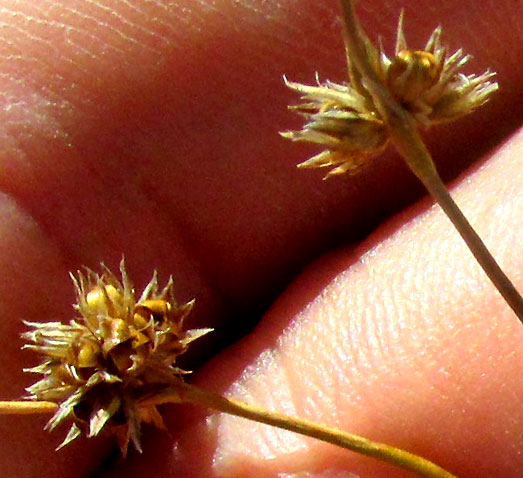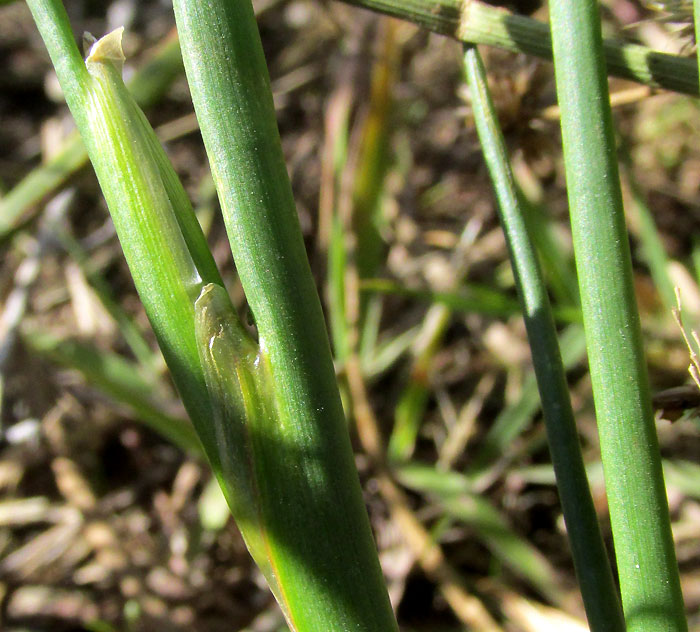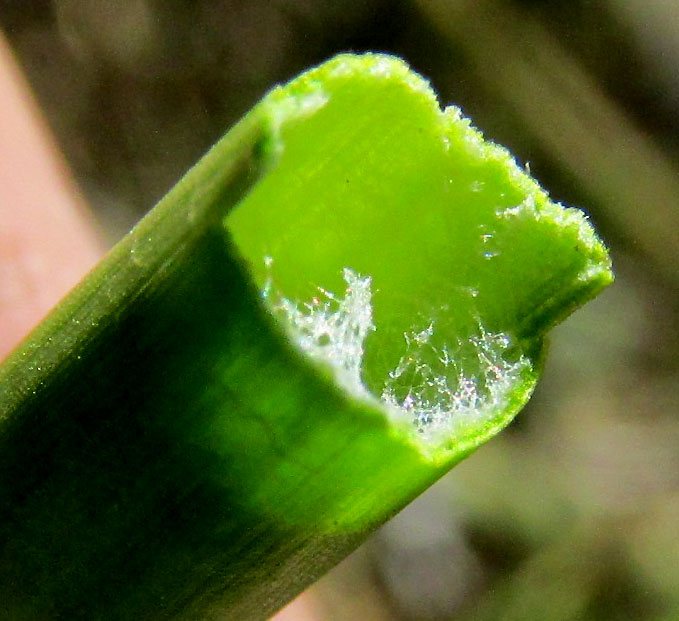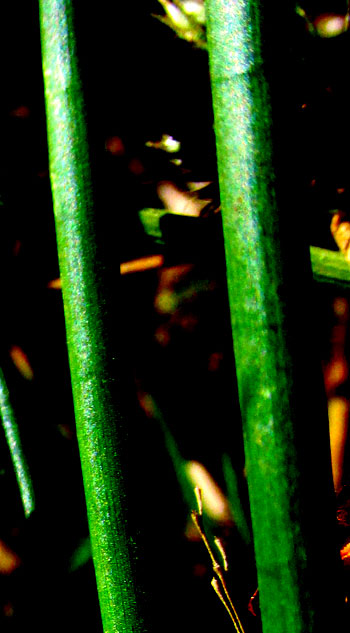Excerpts from Jim Conrad's
Naturalist Newsletter
entry dated September 16, 2022, issued from near Tequisquiapan, elevation about 1,900m (6200 ft), Querétaro state, MÉXICO
(~N20.55°, ~W99.89°)
SHARP-FRUITED RUSH
 On the sometimes-muddy floor of a shallow, grassy-bottomed little ravine, or barranca, the grasslike plant appearing at the right grew thickly amid real grass. A closer look at the flowering heads begins to reveal some of its field marks:
On the sometimes-muddy floor of a shallow, grassy-bottomed little ravine, or barranca, the grasslike plant appearing at the right grew thickly amid real grass. A closer look at the flowering heads begins to reveal some of its field marks:

As seen at the left, the ball-like flower clusters are held distant from one another in a diffuse inflorescence.

Closer still, it's seen that in each flowering head individual flowers already have produced egg-shaped, capsular-type fruits, and that the fruits have split, dispersing their seeds. Each capsule's smooth husk has split into three or so sections, with their dried tips curving inward. The six sharply and slenderly tipped, scale-like items surrounding and rising well above each split-open capsule are look-alike petals and sepals.
All the features mentioned above point to a well known kind of plant commonly occurring worldwide, the rushes, genus Juncus, of the Rush Family, the Juncaceae. Rushes are very different from grasses and sedges. At this writing, the GBIF database recognizes 649 rush species. Of those, in 2015, 31 species were documented for Mexico.


Leaves of many rush species all arise from the base, but our species' leaves can grow from the main stem, as shown above. Among the various species, rush leaf blades can be one of four ways: flat; with a V-shaped groove up its middle (channeled); long and narrow with sharp edges and a pointed tip (ensiform), or; like a cylinder (terete). The picture at the left shows that our plant's leaves are cylindrical, or terete. In species with cylindrical leaves, the interior of the blades can either be empty, or have diaphragm-like partitions appearing at regular distances (septate), probably affording the leaf structural support.

In the above photo of our plant's terete blade, no septum is visible. That was confusing, because at this point in the identification process, the probable species left to deal with all had septate leaves. Often rush species with septate leaves look segmented, but sometimes the septa are not so apparent. In the picture at the right, using an image-editing app, I over-saturated the colors of a leaf in one of our pictures and grossly increased its contrast. On the leaf at the picture's right side, three still-hard-to-see septa are visible. They are so distant from one another that my inside-the-leaf picture had missed any. Our species has septate leaves.
This information left us with two possible species: Juncus nodosus and Juncus acuminatus. In the former, the fruit capsule is so tall and slender that it rises well above the petals and sepals. Also, that species is not documented for our part of Querétaro state. In the latter species, not only does the fruit not rise well above the sepals, but its fruit husk segment tips curve downward, exactly as ours does. Also, Juncus acuminatus is well documented from our area. Therefore, we have JUNCUS ACUMINATUS.
Juncus acuminatus bears several English names, with Sharp-fruited Rush and Tapertip Rush being about equally popular, but also there's Tufted Rush and other names. It occurs in wet meadows, springs, ditches, swamps, shores and rock outcrops from southern Canada south through Mexico to about Honduras, plus it occurs as an invasive elsewhere, especially in New Zealand and southeastern Australia.
Little information about Juncus acuminatus is available, but in general rushes are of great ecological importance. Often along shore and in marshes they're abundant, usually mingling with other species. Their deep, fibrous roots keep the soil from eroding. Certain birds in such environments feed on rush seeds, and mammals graze on leaves and shoots. Certain birds use rushes as nesting material. In various cultures larger rush species have been used for weaving and making wicker chair bottoms.